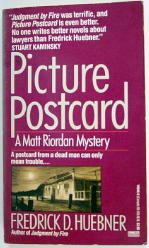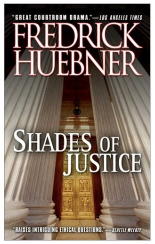December 2008
Monthly Archive
Fri 5 Dec 2008
REVIEWED BY WALTER ALBERT:
UNKNOWN VALLEY. Columbia, 1933; Lambert Hillyer, direction and screenplay; Charles “Buck” Jones, Cecilia Parker, Wade Boteler, Frank McGlynn, Ward Bond, Arthur Wanzer, Alf James, Brett Black, Frank Ellis, Gaylord Pendleton and “Silver.” Shown at Cinecon 41, September 2005.
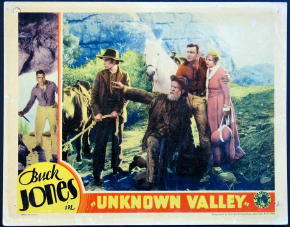
An unusual western. Buck, in search of his missing father, after crossing a desert to a range of mountains where his father appears to have been heading, stumbles on a community of religious extremists.
Buck discovers that their leaders, Ward Bond and Wade Boteler, have been mining for gold with the help of Buck’s missing father, now their prisoner, and plan to escape shortly with their loot.
The religious sect is not really identified, but they are (with the exception of their treacherous leaders) peaceful folk, who want only to maintain their way of life without interference from outsiders.
Buck was my favorite cowboy hero when I was a kid, and I think I had good taste. An intelligent film that has enough thrills and suspense to keep an audience enthralled.
Fri 5 Dec 2008
FREDRICK D. HUEBNER – The Joshua Sequence.
Fawcett Gold Medal; paperback original. First printing, November 1986.
[Rather than make any changes, I’m going to leave this review pretty much as it was written, back in early January 1987. You’ll see why in a moment. Keep reading.]
I guess I’m getting old. It’s not so much that I’ll be 45 years old tomorrow, because I really don’t think that’s what I’m feeling. It’s more that for the past few semesters I’ve gotten the feeling that for the students in my classes, the Vietnam War is something they’ve only read about, in history books, and not from newspapers.
And here in The Joshua Sequence we have a mystery novel with the root causes based in the early 70s, with the various underground movements, the bombings, the thoughts (carried over from the 60s) that protests could change the world. The longer Seattle lawyer Matt Riordan searches for the killer of former student activist Stephen Turner, now a computer programmer, the more sure he becomes that the reason is connected with Turner’s days with the Weathermen and the Northwest Nine.
Ancient history. Has it been 15 years ago, already? In the passage of time, most of Turner’s co-conspirators have gone establishment, in one form or another, depending on how you define the term, but there is a secret from those earlier days that one of them does not want revealed. And therein lies the mystery.
Drugs, and a government cover-up, are also involved. Lacking sufficient muscle, Riordon has to call in a private eye friend from Montana. He also gets too closely involved with his client, the dead man’s sister. You can probably write the rest from here.
Huebner is also a lawyer, so here in his first novel, he is writing largely what he knows, but every so often I thought his ear for dialogue was off. It may look good in print, but as opposed to the recently reviewed Death of a Harvard Freshman, I don’t think this is the way people really talk. There are an awful lot of typos, too.
Or maybe I’m just getting cranky in my old age?
— From Mystery.File 1, January 1987 (slightly revised).
[UPDATE] 12-05-08. No further personal comment is necessary from me, I don’t believe. My copy of the book is packed up and stored away where I can’t get to it, so I don’t have a cover image to show you. Next best thing, though: a cover shot of one of his other Matt Riordan books, then a scan of his most recent book. And why not a complete bibliography for him also, expanded from the Revised Crime Fiction IV, by Allen J. Hubin:
HUEBNER, FREDRICK D. 1955- . MR = Matthew Riordan.
* The Joshua Sequence. Gold Medal, pbo, 1986, MR
* The Black Rose. Gold Medal, pbo, 1987. MR
* Judgment by Fire. Gold Medal, pbo, 1988. MR
* Picture Postcard. Columbine, hc, 1990; Gold Medal, ppbk, 1991. MR
* Methods of Execution. Simon & Schuster, hc, 1994; Gold Medal, ppbk, May 1995. MR
* Shades of Justice. Simon & Schuster, hc, 2001; Signet, ppbk, Jan 2003.
Fri 5 Dec 2008
A 1001 MIDNIGHTS Review by Marcia Muller & Bill Pronzini:
JUDSON PHILIPS – The Laughter Trap. Dodd Mead, hardcover, 1964. Hardcover reprint: Detective Book Club [3-in-1 edition], December 1964. Paperback reprint: Pinnacle P154N, January 1973.
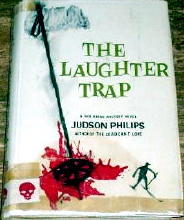
Although his work as Hugh Pentecost is better known, Judson Philips has published some excellent novels of suspense and detection under his own name, and created one notable series character — Peter Styles, a national columnist for Newsview magazine who specializes in human-interest stories.
The Laughter Trap is the first of many novels featuring Styles and dramatizes the tragic events that irrevocably altered the shape of his life and career.
While on their way home from the Darlbrook Lodge in the Green Mountains of Vermont, Styles and his elderly father, Herbert, a successful but alcoholic advertising executive, are forced off the road by two thrill killers. Herbert Styles dies in the fiery wreck; Peter is thrown free, but sustains a serious injury that forces doctors to amputate his right leg halfway between the ankle and the knee.
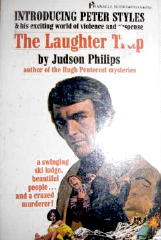
He recovers with the help of a former lover, Liz Connors, whose husband is a doctor specializing in prosthetic devices. His new artificial leg allows him to move around with only the slightest limp, and once he has recovered, he devotes his life to an ongoing search for the men who cost him his father and his leg. His only clue is the “hideous high giggling laugh” he heard before the crash.
All of this is told in flashback and through conversations with others as Styles returns a year later to Darlbrook Lodge. He has wired for private accommodations, but ends up sharing a room with the lodge’s publicity man, Jim Tranter, through whose eyes we view the rest of the story.
Styles’s first evening at the lodge is without unusual incident — until he awakens Tranter in the middle of the night, claiming he has again heard the hideous laughter. In the morning, a much more disturbing event is revealed: Two young women staying in one of the cabins — Jane Pritchard and Martha Towers have been brutally stabbed to death. Jane Pritchard’s father appears on the scene, accompanied by his other daughter, Laura, and offers a reward for the apprehension of the slayer.
Styles interests himself in the investigation, believing the killings and the laughter he heard have a connection. By the time he solves the grisly double homicide, the usually peaceful atmosphere of the mountain lodge has been disrupted by yet another killing, an attempted murder, a melee in the bar, and dangerous undercurrents of hatred and suspicion. But while Styles finds satisfaction in the resolution of the case, he finds only frustration in his search for the driver of the car who took his father’s life.
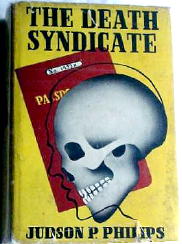
Styles continues his quest in such other novels as The Twisted People (1965), Nightmare at Dawn (1970), Walk a Crooked Mile (1975), and Why Murder (1979).
Of the other series characters created by Philips under his own name, the most interesting are Carole Trevor of the Old Town Detective Agency and her ex-husband, wealthy man-about-town Maxwell Blythe, who appear in two early mysteries: The Death Syndicate (1938) and Death Delivers a Postcard (1939).
———
Reprinted with permission from 1001 Midnights, edited by Bill Pronzini & Marcia Muller and published by The Battered Silicon Dispatch Box, 2007. Copyright © 1986, 2007 by the Pronzini-Muller Family Trust.
Thu 4 Dec 2008
VICTORIA SILVER – Death of a Harvard Freshman.
Bantam; paperback original; 1st printing, April, 1984.
Dialogue is an important component of mystery fiction — the most devious plots are often undone by speech patterns that border on either the most stilted or the most incomprehensible, but I am convinced that Harvard freshmen really do talk like the characters in this book. Central Connecticut State (where once I taught) is not Harvard, by any means of comparison, but it is not Outer Slobovia, either, and I think I’m a reasonable person to judge.
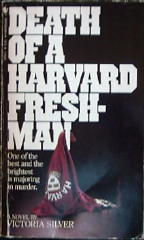
(Mostly I talked to students about courses, grades, and whatever it is that actuaries actually do, and not about personal things like life, sex and whatever else it was that consumed the thinking time of college students back in the mid-1980s, but I still think I’m a reasonable person to judge. Or I was then.)
Sort of surprisingly enough, this is very much a classical detective story, rather uncommon today, with a limited number of suspects (the fellow members of Lauren Adler’s freshman seminar on the Russian Revolution), a great amount of misdirection in the matter of solving the murder of black student activist Russell Bernard — or rather suspicion directed equally in all directions — and clues derived solely from large amounts of conversation, pieced together from differing accounts of each suspect’s activities and personalities, with very little physical action involved.
This is also very much an amateur investigation. The police do what they do offstage, and only one faculty member has a major speaking role. Besides the murder — as in the case of Rasputin, perhaps to destroy Russell’s political influence — and its solution, this is also a novel in which each of the characters are seeking their own identity — whether Jewish, black, gay, southern aristocrat, preppie, or L.A. modern.
I’ll say it again. The characters are real. This is one book I wouldn’t mind reading again, and there are few mysteries I would ever say that about.
Note: Silver’s second mystery, Death of a Radcliffe Roommate (Bantam, 1986), has been published already, and it also features Lauren Adler. Without expanded its borders beyond that of the campus community, this would seem to be a very limited series of books. But as long as I’m nowhere in the vicinity of a school where Lauren’s nearby, I’m really pleased that we haven’t yet seen the last of this fascinating young lady.
— From Mystery.File 1, January 1987 (revised).
[UPDATE] 12-04-08. Most of the revisions were made to reflect that I’m no longer teaching, so what I know about current students’ speech patterns is rather problematical. What I was comparing, though, were students in the 1980s and they way they talked and the way the students talked in Victoria Silver’s book, which also took place in the 1980s.
“Victoria Silver,” by the way, is not the author’s real name, and as far as I know, it is not known who the real author was. I suspect that many of the characters in her books were based on people she actually knew. (Googling for more information on her, most of the web pages that came to view were about, you guessed it, Victoria silver.)
And as I also suspected in the last paragraph of my review, at least between the lines, these were the only two cases of murder in which Lauren Adler ever found herself involved.
Thu 4 Dec 2008
REVIEWED BY WALTER ALBERT:
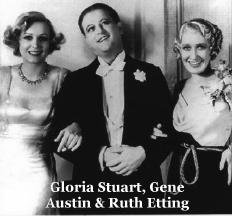
GIFT OF GAB. Universal, 1934; Karl Freund, director; Edmund Lowe, Gloria Stuart, Ruth Etting, Gene Austin, Alice White, Victor Moore, Ethel Waters, Chester Morris, Bela Lugosi, Boris Karloff, Phil Baker, Gus Arnheim and his orchestra. Shown at Cinecon 41, September 2005.
Don’t let the cast list get your hopes up. This is an anthology film, and the most interesting cast members make very brief appearances, so brief in some instances that when several of us talked about the film later we couldn’t agree on which actors actually appeared in the film and in what capacity.
Edmund Lowe is a street huckster who worms his way into radio and up the corporate ladder to become, albeit briefly, an airwaves star. This may have been heavily edited. The story line doesn’t really hang together and some of the guest stars should have fired their agents for letting them get involved in such a lame enterprise.
Thu 4 Dec 2008
A 1001 MIDNIGHTS Review by Karol Kay Hope:
W. R. PHILBRICK – Slow Dancer. St. Martin’s Press, hardcover, 1984.
Mystery fiction has seen more women detectives hang out their shingles in the last five years than in its entire history. Naturally, most of these characters are written by women, fueled by a personal understanding of the modem woman’s changing role. W. R. Philbrick is one of the few men who can write a modem female detective and make us believe her.
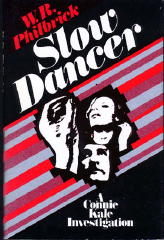
Connie Kale has no one to rely upon but herself. Her dad’s still alive, but a massive stroke has taken his speech and his mobility. A golf pro for thirty years, he can only remind Connie that she’s not the Women’s Golf Champion of the World, a title for which he prepared her since childhood.
Her first year on the circuit cracked her nerve — something about being a very small fish in a very big pond — and she’s returned to her small New England hometown to start a new career as a private investigator.
Her clients value her knowledge of the community and her graceful sense of discretion. She cleans up the messes in their lives with no one the wiser — no small talent in a small town.
In Slow Dancer, though, it looks like she might not pull it off. Mandy O’Hare has gotten herself killed in a sleazy motel room after one of those dives into decadence only the rich can afford. Mandy’s daddy and grampa have always bought her out of trouble before, but this time all they can manage is to keep the sordid details hushed up. Daddy, you see, is running for governor, about to realize grampa’s greatest and last ambition for him. This is grampa’s last gasp, and Mandy’s death, allegedly at the hands of a local male stripper, is not going to stop him.
This family of aristocrats is being eaten away from within, and grampa wants to know who is rotten and who is not. Connie’s father was the old man’s golf pro, and Connie is practically a member of the family herself. (She and Mandy used to play on the estate together when baby girls.) Old man O’Hare figures if anybody can find out what’s going on and keep her mouth shut about it, Connie can.
Connie, however, has her doubts. Mandy was a brat, and the family is already tainted by suicide, infidelity, and insanity. Besides, murder is hard to cover up anyway, no matter who you are.
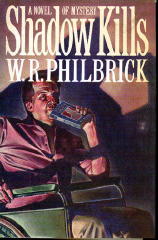
It’s a Pandora’s box, and by the time Connie lets all the contents out, this great and powerful family is exposed for the cesspool it is, and Connie barely escapes with her life.
Philbrick writes exceptionally well; his prose sparkles. And he writes Connie well, although women readers might wish to see more of her softer edges than Philbrick shows.
Philbrick’s other novels are [non-mystery] Shooting Star (1982) and Shadow Kills (1985). The latter will be of particular interest to mystery buffs, as its hero is a mystery writer who is confined to a wheelchair.
———
Reprinted with permission from 1001 Midnights, edited by Bill Pronzini & Marcia Muller and published by The Battered Silicon Dispatch Box, 2007. Copyright © 1986, 2007 by the Pronzini-Muller Family Trust.
Wed 3 Dec 2008
Posted by Steve under
ReviewsNo Comments
REVIEWED BY TED FITZGERALD:
LAWRENCE BLOCK – The Girl with the Long Green Heart.
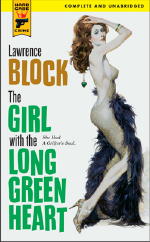
Hard Case Crime; reprint paperback, November 2005. Previously published as a paperback original: Gold Medal k1555, 1965. Other reprint editions include: Foul Play Press, ppbk, 1985; Carroll & Graf, ppbk, July 1994; Five Star, hc, May 1999.
What a perfect title and what a perfect McGinnis Carter Brown-type cover! One of Lawrence Block’s minor distinctions is that he may be the only writer to have set a crime novel in Olean, N.Y.
This is a grafter noir narrated by an erstwhile con man who’s been jolted into the straight life by a prison sentence. But when an old pupil comes to him with a clever con that plays on the resentment of a big deal small town businessman who’s been conned on a Canadian land deal, our boy is in.
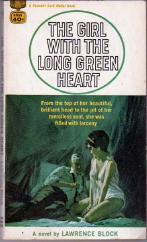
His interest is perked in no small way by an impromptu inside player: the mark’s secretary/mistress, a woman who picks up things (including the narrator) quickly and seems born to the grift.
Well, there aren’t a lot of unexpected twists and turns here, at least not to an audience that’s grown up with variants of the Big Store con ranging from Mission: Impossible to The Sting. But the pleasure is in the smooth narrative voice Block provides, the confidence trickster detail that’s laid out and an ending with a quiet twist that’s based on character.
Nice job.
— Reprinted from
A Shoe in My Hand #9, November 2005.
Wed 3 Dec 2008
EDWARD S. AARONS – Assignment: Zoraya.
Gold Medal #979. Paperback original; first printing, March 1960. Reprint editions include Gold Medal T2616, 1972, with a new cover (shown).
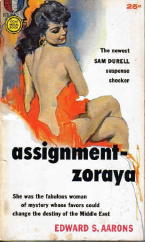
Now this. Not putting down any of the other books reviewed this issue, this is the real thing. The eleventh of CIA agent Sam Durell’s violent around-the-world adventures, it possesses a drive and story-telling intensity unmatched by very few writers today.
I have mentioned before that I don’t read spy thrillers at all any more, but that wasn’t really true. I don’t read today’s bloated novels of Nazi hunts or nuclear conspiracies, and I seldom read convoluted LeCarrean tales of cold war intrigue, but I do read Edward S. Aarons.
One wonders if Aarons ever travelled to all the places he describes so well. This story takes Durell from sunny Geneva to the picturesque Mediterranean island of Elba to the hot burning deserts surrounding the small Arabian port city of Jidrat, and in each place we get the unmistakable feeling that we are actually there. One suspects it is because Aarons also had a sense of history as well.
Durell’s mission in this book: to return decadent Prince Amr al-Maari to his homeland, in a last-ditch attempt to provide leadership to a country about to undergo a bloody revolution. Zoraya is his wife, married when she was but eight years old, but repudiated ever since by Amr, she has spent her life simply waiting for him. If anyone can assist Durell in forcing the Prince out of his present life of drunken debauchery, it is she.

Coincidence is very much a part of every good writer’s stock-in-trade, but unlike the whopping one leading off Nick O’Donohoe’s book [reviewed here not so long ago], only one of Aarons’ characters — the Jewish-Hungarian wife of Major Kolia Mikelnikov, Durell’s Russian counterpart — comes on the scene solely by accident, and even that is made plausible.
When the stage is set, the drama that then plays itself out on the blood-splattered streets of Jidrat and the besieged palace of Amr’s grandfather is clearly not fun and games.
Here’s a description of Sam Durell that sums him up pretty well (page 130): “…you do things in the name of duty which you really do not have to do.”
— From Mystery.File 1, January 1987 (slightly revised).
[UPDATE] 12-03-08. Nope, I don’t remember this one either. I could easily read it again, after reading what I had to say, but I haven’t yet read all of the other Sam Durell adventures, so I probably won’t. Not right away, anyway.
I wonder why I was so down on John Le Carré at the time. I still don’t read bloated novels of Nazi hunts or nuclear conspiracies, but I while I haven’t recently, I have no aversion to reading anything by the man who wrote The Spy Who Came in from the Cold. That’s a book I definitely do remember, and I read it when it first came out.
Wed 3 Dec 2008
Posted by Steve under
ReviewsNo Comments
A REVIEW BY MARY REED:
JOHN KENDRICK BANGS – R. Holmes & Co: Being the Remarkable Adventures of Raffles Holmes, Esq., Detective and Amateur Cracksman by Birth. Harper & Brothers, hardcover, 1906. Paperback reprint: Otto Penzler Books, 1994.
The family of writer Jenkins is temporarily out of town. On a blistering hot night he is dozing in a hammock on the fire escape when a nocturnal visitor climbs up it and pops into his flat.
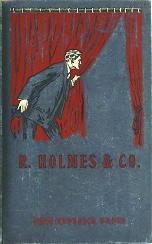
Surprised to say the least, Jenkins follows the burglar to his library, where he finds him perusing royalty statements. The visitor is Raffles Holmes, son of Sherlock and grandson of A. J., and he is there to suggest, if he finds these statements satisfactory, that Jenkins record some of his exploits for mutual financial gain. Besides which, he says, Jenkins needs some new ideas for his fiction. Ouch!
Here follow a few lines about the various adventures related by Jenkins, hopefully without giving too much of their plots away.
● The Adventure of the Dorrington Ruby Seal relates how Raffles Holmes’ parents met during the hitherto unrecorded case of a jewelry theft from Lord Dorrington stately home, the swag including an immensely valuable ruby seal given to the family by George IV. Raffles Holmes’ mother’s name is Marjorie, daughter of A.J. Memo: who was her mother? Though Bunny did hint Raffles’ had a number of escapades with the ladies…
● The Adventure of Mrs Burlingame’s Diamond Stomacher underlines the constantly warring nature of Raffles Holmes — an insistent desire to pinch things and the equally strong wish to bring malefactors to justice. When Mrs B’s highly valuable stomacher is stolen, her dinner guests, despite being the cream of society, are under a cloud of suspicion. To say more would be to reveal Raffles Holmes’ cunning plan to collect the reward money for its return.
● The Adventure of the Missing Pendants involves a theft from Gaffany & Company, whose craftsmen are cutting a section of a fabulous diamond into four pendants. Two pendants go missing, and the solution involves Raffles in disguise and a water cooler.
● The Adventure of the Brass Check comes about because everyone expected Mrs Wilbraham Ward-Smythe has a rope of enormous pearls and everyone knows it. Raffles Holmes hatches a clever plan to claim a reward for its return without actually stealing the pearls.
● The Adventure of the Hired Burglar involves an attempt to save the reputation of a man who has been up to no good with someone else’s bonds and must produce them in a very short time when their owner reaches majority, Raffles Holmes agrees to help out, but this leads to a triple cross…
● The Redemption of Young Billington Rand is necessary because while Rand is an honourable man he is also weak, and as a result is now more or less bankrupt and owes money right, left, and at the club. Raffles Holmes intervenes to save him from taking a criminal step.
● The Nostalgia of Nervy Jim The Snatcher is for his cosy jail cell, preferably for ten or more years, as the old lag cannot cope with life outside prison. To help him achieve his wish, Raffles Holmes and Jenkins sing in the chorus of Lohengrin at a performance at which Mrs Robinson-Jones’ valuable necklace is stolen.
● The Adventure of Room 407 involves an intercepted telegram and a man masquerading as a member of the nobility, but despite a promising start it is perhaps the least of the stories related by Jenkins.
● The Major-General’s Pepperpots are a massive golden pair, a gift from the King of Spain, as now General Carrington Cox relates. Stolen some years before, Raffles Holmes sees one on a friend’s dinner table and he has the other by way of a sentimental event. After hearing why Carrington Cox was given the pepperpots, Raffles Holmes decides he must do something….
My verdict: Fans of Holmes and Raffles will find this collection amusing and some of the planning and execution worthy of old Hawkface himself. The criminal collation tends more to the Rafflian turn of phrase than the Holmesian, and I must admit I laughed out loud when, after Raffles Holmes whacks Jenkins on the shoulders and almost topples him into the fireplace, the former declares “Don’t be a rabbit. The thing will be as easy as cutting calve’s-foot jelly with a razor.”
It’s well worth spending an hour or two with Bangs when readers fancy something a little lighter than usual in the criminous literary line.
Etext: http://manybooks.net/titles/bangsjoh2055920559-8.html
Wed 3 Dec 2008
JOHNNY RYAN. Made for TV. 1990. Clancy Brown, Julia Campbell, Jason Beghe, Robert Rossilli, J. Kenneth Campbell, Teri Austin, Robert Prosky. Director: Robert E. Collins.
So far my research hasn’t turned up which network or cable channel first telecast this very much retro-1940s cops-against-organized-crime show, but IMDB says the date was 29 July 1990. My copy came from Encore’s Mystery Channel some time later on, but that’s no help.

IMDB also says the story takes place in 1949. Could be, but it felt more like 1946 to me, just after the war, when old Model T’s were still on the road and little else but old coupes and boxy sedans were available.
As far as the cast is concerned, they’re all pretty much unknown to me. Clancy Brown plays Johnny Ryan, the stalwart new head of a special task force against the mob in Manhattan, very much in the Robert Stack mode, complete with pulled down brim.
His broad features (but still good-looking) and Bronxish accent (at least in this film) hardly made for very many other leading roles. Most of his subsequent career has been as a voice artist for superhero cartoons.
The picture you see of him here is not from this TV movie, I’m sorry to say, but it’s from the same time period. I also apologize that it’s in black and white. The film’s in color.
Johnny’s job in the movie is to break the stories of the two cops supposedly watching an important witness in a hotel room. (The witness is thrown from the window when their backs are turned.)

Night club owner Steve Lombardi (either Jason Beghe or Robert Rosilli – IMDB lists them both) is in on the killing. When Johnny tries to find a way to get at him, he uses Lombardi’s girl friend and club entertainer Eve Manion (Julia Campbell), not expecting the next obvious plot twist, but the avid viewer of movies of this type certainly will. (The photo here of Julia Campbell is not in 1940s mode, but it’ll give you an idea.)
There are a few other plot twists, but none of them are particularly earth-shattering, or even bending. Well, maybe bending. I certainly didn’t mind the 95 minutes or so it took to watch this movie. If it happened to be a pilot for a projected series, which is a strong possibility, I’d have wanted to see more, but I’m a sucker for this kind of stuff. Maybe nobody else is.
« Previous Page — Next Page »

